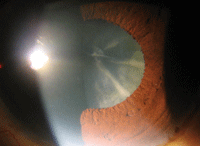American adults near or below the poverty line are significantly less likely to seek vision care services than their wealthier counterparts, according to a study in JAMA Ophthalmology online. Lower education levels also mean fewer visits to the eye doctor.

Low income Americans are less likely
to seek eye care for age-related eye
diseases, such as cortical cataracts.
In this analysis, National Institutes of Health senior epidemiologist Xinzhi Zhang, MD, PhD, and associates evaluated data from 6,690 total participants in the 2002 and 2008 National Health Interview Survey. Respondents were at least 40 years old and had one age-related eye disease––including macular degeneration, cataracts, diabetic retinopathy or glaucoma. The researchers also documented participants’ poverty-income ratio (PIR) and education level.
In 2002, 62.7% of respondents with the lowest PIR scores (<1.50) visited an eye care provider within the previous 12 months, compared to 80.1% of those with the highest PIR scores (>5.00). The 2008 results were similar (61.4% with a PIR less than 1.50 vs. 78.3% with a PIR greater than 5.00).
Further, 62.9% of 2002 study participants with less than a high school degree saw an eye care provider within the prior 12 months, compared to 80.8% of those with a college degree. Again, comparable results were documented in the 2008 study (58.9% with less than a high school degree vs. 78.2% with a college degree).
“Given that income and educational level are important social determinants of health, both society and individuals have the responsibility and capability to influence and help reduce such disparities,” Dr. Zhang wrote in an email to Medscape Medical News. “Eye care providers, as well as primary care providers, should more proactively educate patients with low socioeconomic status about the importance of regular eye examination. More community-participated public health interventions to reduce eye care disparities are needed to further engage both patients and physicians.”
Zhang X, Beckles GL, Chou CF, et al. Socioeconomic disparity in use of eye care services among US adults with age-related eye diseases: National Health Interview Survey, 2002 and 2008. JAMA Ophthalmol. 2013 Jul 18. [Epub ahead of print]

